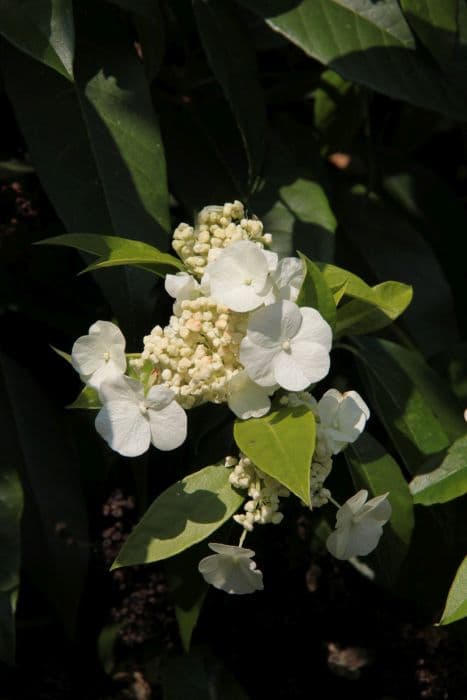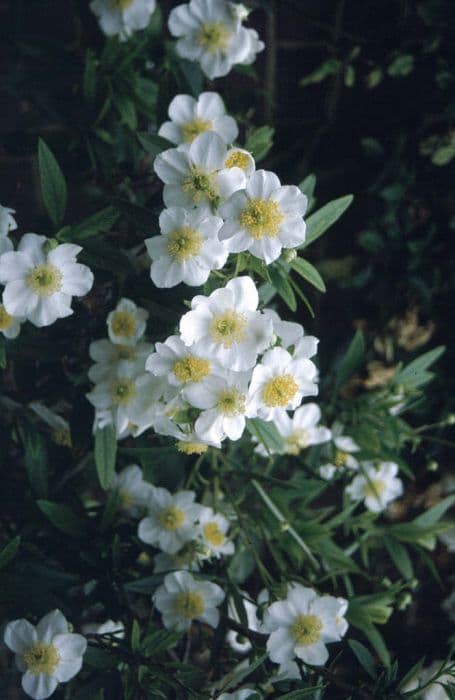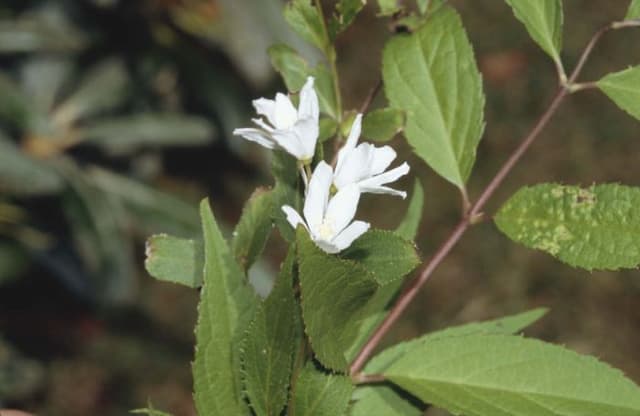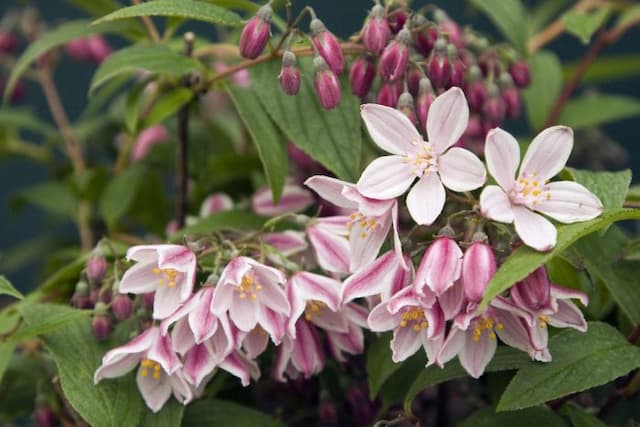Seemann's Hydrangea Hydrangea seemannii

ABOUT
Hydrangea seemannii, commonly known as the Climbing Hydrangea, is a robust evergreen vine that showcases lush, dark green leaves which are leathery to the touch, with a glossy finish that adds to their attractive appearance. The leaves of this plant often grow opposite each other along the stems, and each leaf typically bears a rounded or broadly pointed shape. The margins of the leaves are finely toothed, providing a subtle texture. The Climbing Hydrangea is admired for its beautiful flower clusters that emerge as striking additions to the greenery. These flower displays consist of small, fertile florets at the center, which are often creamy-white and less conspicuous. They are surrounded by larger, showy, unfertile flowers that have a ring-like arrangement and give the overall bloom cluster a lacecap effect. These showy flowers help to attract pollinators and add a visual interest to the plant. Developing buds and the young growth of the Climbing Hydrangea may have a slightly fuzzy texture, enhancing the tactile experience of the plant. The mature vines often exhibit peeling bark, which contributes an extra layer of texture and rustic charm to its overall appearance. As the name suggests, the Climbing Hydrangea has a climbing habit, making it a favorite for growing up walls, trellises, or other supports where it can be trained to create a lush, vertical display of greenery and blooms. Its aerial roots help it cling to surfaces, giving it the ability to cover spaces with its foliage and flowers, thus providing a dense and attractive cover. The pervasive presence of this plant, coupled with its decorative appeal, makes it a popular choice in gardens where it can be accommodated to soften structures and integrate with the landscape design.
About this plant
 Names
NamesFamily
Hydrangeaceae
Synonyms
Evergreen Climbing Hydrangea, Seemann's Hydrangea
Common names
Hydrangea seemannii
 Toxicity
ToxicityTo humans
Climbing Hydrangea contains compounds that can be toxic if ingested. The toxicity primarily comes from the presence of cyanogenic glycosides, which can release cyanide in the body when the plant material is chewed and digested. If someone ingests parts of the Climbing Hydrangea, they might experience symptoms of mild poisoning, which can include nausea, vomiting, stomach pain, diarrhea, and sweating. In more severe cases, difficulty breathing, dizziness, fainting, or convulsions could occur due to the effects of cyanide. The highest concentration of these toxic compounds is typically found in the leaves and buds, but all parts of the plant should be considered potentially harmful if consumed.
To pets
Climbing Hydrangea is also toxic to pets if ingested due to the presence of cyanogenic glycosides. These compounds can release cyanide into an animal's system, leading to potential poisoning. Signs of toxicity in pets may include symptoms such as vomiting, diarrhea, lethargy, abdominal pain, and more serious manifestations such as difficulty breathing, seizures, or collapse in cases of significant ingestion. As with humans, all parts of the plant are potentially dangerous if consumed by pets, with higher toxicity in the leaves and buds. If you suspect your pet has ingested Climbing Hydrangea, it is important to contact a veterinarian immediately.
 Characteristics
CharacteristicsLife cycle
Perennials
Foliage type
Evergreen
Color of leaves
Green
Flower color
Cream
Height
15 feet (4.57 meters)
Spread
6 feet (1.83 meters)
Plant type
Climber
Hardiness zones
8
Native area
Mexico
Benefits
 General Benefits
General Benefits- Ornamental value - Hydrangea seemannii, commonly known as the climbing hydrangea, adds aesthetic value to gardens with its lush foliage and showy flowers.
- Shade provider - With its broad leaves, it can create shaded areas, which can be beneficial for understory plants that thrive in diffused light.
- Vertical interest - As a climbing vine, it can grow on walls, trellises, or trees, adding dimension and interest to garden spaces.
- Seasonal interest - It produces flowers in late spring and summer, which can add seasonal appeal to gardens and landscapes.
- Habitat for wildlife - The plant can provide shelter and nesting areas for birds and insects, increasing local biodiversity.
- Erosion control - Its root system can help stabilize soil on slopes, reducing the risk of erosion.
- Privacy screen - When grown on fences or trellises, it can function as a living privacy screen, blocking unwanted views and reducing noise.
 Medical Properties
Medical PropertiesThis plant is not used for medical purposes.
 Air-purifying Qualities
Air-purifying QualitiesThis plant is not specifically known for air purifying qualities.
 Other Uses
Other Uses- Climbing Cover: Hydrangea seemannii, also known as evergreen climbing hydrangea, can be used to create a living wall or to cover unsightly structures, providing year-round foliage and aesthetic appeal.
- Privacy Screening: It can be trained to grow over fences or in front of privacy screens, helping to block out neighbors and reduce noise pollution.
- Shade Provider: When grown over arbors or pergolas, Hydrangea seemannii can provide natural shade to seating areas or patios in the garden.
- Erosion Control: This plant's root system can help stabilize soil on slopes or in areas prone to erosion, making it an environmentally friendly landscaping choice.
- Wildlife Habitat: The dense foliage of Hydrangea seemannii offers shelter and nesting sites for birds and beneficial insects within the garden ecosystem.
- Garden Focal Point: Due to its large, showy clusters of flowers, it can serve as a striking focal point in garden design.
- Seasonal Interest: The blooms of Hydrangea seemannii add seasonal interest to the garden, often changing color as the weather cools, which can enhance the visual dynamics of a garden space.
- Theme Gardens: This plant can be used in thematic garden designs, such as Victorian or cottage-style gardens, because of its lush, old-fashioned appearance.
- Photography Backdrop: The hydrangea's large, attractive blooms and evergreen leaves make an excellent backdrop for garden photography and botanical art.
- Educational Resource: Horticulture students and gardening enthusiasts can use Hydrangea seemannii as a living example to study climbing plant habits, pruning techniques, and propagation methods.
Interesting Facts
 Feng Shui
Feng ShuiThe plant Climbing Hydrangea is not used in Feng Shui practice.
 Zodiac Sign Compitability
Zodiac Sign CompitabilityThe plant Climbing Hydrangea is not used in astrology practice.
 Plant Symbolism
Plant Symbolism- Heartfelt Emotions: Hydrangeas symbolize deep, heartfelt emotions due to their lush and abundant flower heads, with the Seemannii variety sharing this trait.
- Gratitude: The giving of hydrangeas often represents thankfulness and gratefulness for understanding, which is also common in Seemannii hydrangeas.
- Apology: Historically, hydrangeas have been given as a way to express an apology, a gesture that can extend to the Seemannii species as well.
- Boastfulness or Vanity: In some cultures, hydrangeas are associated with boastfulness due to the plant's abundance of petals and showy appearance; Seemannii hydrangeas can be seen in a similar light.
- Perseverance: Hydrangeas, including Seemannii, can represent perseverance as they are hardy plants and can bloom even in harsh conditions.
 Water
WaterEvergreen Climbing Hydrangea should be watered deeply once a week, allowing the soil to partially dry between waterings. During hot or dry weather, increase watering to twice a week. Apply around 1 to 1.5 gallons of water each time, ensuring it reaches the root zone. Reduce watering in the winter when the plant is not actively growing.
 Light
LightEvergreen Climbing Hydrangea prefers dappled sunlight or partial shade; direct sunlight can scorch the leaves. The ideal spot is one where morning sun is available with afternoon shade, or a location with filtered light throughout the day.
 Temperature
TemperatureEvergreen Climbing Hydrangea thrives in temperatures between 60°F and 80°F. It can tolerate a minimum temperature of about 30°F during winter dormancy but should be protected from prolonged freezes. Ideal growing conditions do not include extreme heat, so during summer, ensure the plant is not exposed to temperatures above 80°F for extended periods.
 Pruning
PruningPrune Evergreen Climbing Hydrangea in late winter or early spring before new growth begins. This keeps the plant healthy and encourages new growth and flowers. Remove dead, damaged, or overly crowded branches. Pruning every year or two is typically sufficient.
 Cleaning
CleaningAs needed
 Soil
SoilSeemann's Hydrangea requires well-draining, rich, loamy soil with plenty of organic matter. The best soil pH for this plant is slightly acidic to neutral, ranging from 5.5 to 7. A good mix could be equal parts garden soil, compost, peat moss, and perlite to ensure soil aeration and moisture retention.
 Repotting
RepottingSeemann's Hydrangea should be repotted every 2 to 3 years to refresh the soil and accommodate root growth. However, larger specimens can be repotted less frequently if they are otherwise healthy and not showing signs of being root-bound.
 Humidity & Misting
Humidity & MistingSeemann's Hydrangea thrives in environments with moderate to high humidity levels. Ideal humidity conditions for this plant would be between 60% to 80%, mirroring the moist conditions of its native habitat.
 Suitable locations
Suitable locationsIndoor
For Seemann's Hydrangea, provide indirect light and keep the soil moist.
Outdoor
Plant Seemann's Hydrangea in dappled shade and moist, rich soil.
Hardiness zone
8-10 USDA
 Life cycle
Life cycleSeemann's Hydrangea (Hydrangea seemannii) begins its life as a seed, typically germinating in moist, well-drained soil in partial to full shade. After germination, the seedling emerges and develops into a young plant with a small root system and several sets of leaves. As it matures, Seemann's Hydrangea grows into a climbing shrub with aerial roots, adhering to surfaces for support. The plant enters its flowering stage, producing clusters of creamy white flowers during the summer that attract pollinators. After pollination, the flowers develop into small capsule-like fruits containing seeds that can disperse for reproduction. The plant can also propagate vegetatively through cuttings or layering, and once established, it can live for many years, going through the flowering and seeding cycle annually.
 Propogation
PropogationPropogation time
Spring-Early Summer
The propagation of Hydrangea seemannii, commonly known as the Seemann's hydrangea or evergreen climbing hydrangea, is most popularly done through softwood cuttings. This method is typically carried out in late spring to early summer when the plant’s new growth is still flexible and not woody. Cuttings about 5 to 6 inches long with several leaves are taken from a healthy plant. The lower leaves are removed, and the cut end is dipped in a rooting hormone to encourage root development. The cutting is then planted in a pot filled with a mix of peat and perlite, ensuring good drainage and aeration. The pot should be kept in a warm, humid environment, out of direct sunlight, and the soil kept moist but not waterlogged. Roots usually form within 4 to 6 weeks, after which the new plants can be gradually acclimated to less humid conditions before being planted out.







![Hydrangea [Strong Annabelle]](/_next/image?url=https%3A%2F%2Fplants-admin.emdemapps.com%2Fimages%2Fplants%2F%2Fimages%2F604b54db37d34.png&w=640&q=75)

